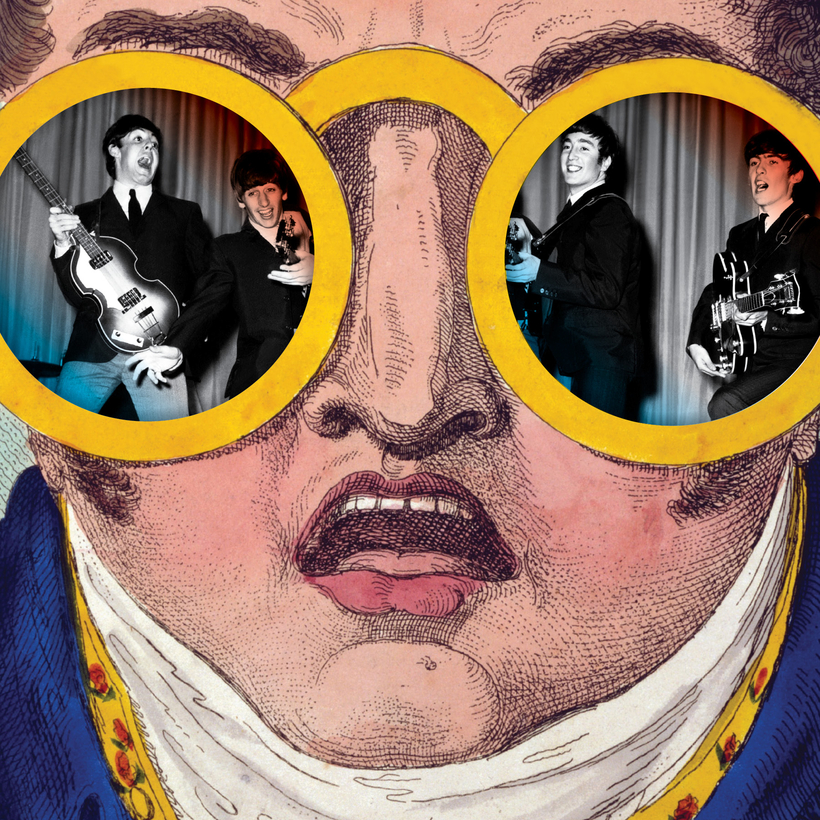In the mid-1990s, as the surviving Beatles were putting the finishing touches on their Anthology series of archival-trawl albums, Paul McCartney and George Harrison joked that their next release would of necessity be called “Scraping the Bottom of the Barrel.” In their minds, there remained no further quality Beatles product worth putting out.
Needless to say, Paul and George were proved wrong. Last month saw the release of Let It Be: 50th Anniversary Edition, featuring a new stereo remix by Giles Martin, the son of the group’s stalwart producer, George Martin, plus various outtakes, alternate takes, and snippets of between-song patter. Given that Let It Be was, sequentially, the group’s final release as a working band (though its recording pre-dated that of Abbey Road), and that this reissue is the last in a series of 50th-anniversary boxed sets of their original studio albums, one might conclude that this is truly the last last time that a Beatles album will be reissued. But c’mon: the Beatles’ catalogue was reissued on CD in 1987, re-reissued in sonically superior stereo and mono editions in 2009, and re-re-reissued in 5.1-surround-sound editions over the last several years. It’s an inevitability that in a few years’ time the process will begin anew, starting with their 1963 debut, Please Please Me, receiving a re-re-re-reissue in a state-of-the-art Meepzorp™ septadimensional mix.
But I suspect that we’ll never again experience the anticipatory excitement over new Beatles content that we felt in the months leading up to this weekend’s immersion in Peter Jackson’s three-part, seven-hour Get Back documentary series, currently streaming on Disney+. Jackson’s remit was to restore and whittle down the last great trove of unreleased Beatles material: the 57 hours of fly-on-the-wall footage shot by the filmmaker (and Air Mail contributor) Michael Lindsay-Hogg in January 1969 for what was released the following year as the 80-minute Let It Be documentary.
Get Back is an exhilarating watch. The colors are vivid, the outfits fantastic, and the four Beatles are still a working unit, if in an advanced state of individuation: John pulling his usual goofy faces but now inseparable from Yoko, Paul bearded and in transition to his Highland-sheep-farmer phase, George tetchy and markedly independent, Ringo droll and dandified. The giddy takeaway is that, praise Vishnu, we are bearing witness to that rarest of commodities, new Beatles stories!

Like many people who have immersed themselves in graduate-level Beatles fandom—reading and re-reading Mark Lewisohn and Ian MacDonald’s Talmudically thorough books about the band, devotedly listening to Peter Asher’s SiriusXM program, From Me to You—I can’t get enough of Beatles stories. To me, theirs is the richest narrative of the 20th century, in that its protagonists were at once four distinct personalities and a quartet of extremely impressionable young men, a tabula rasa onto which was projected nearly every trend and movement of the 60s: recreational-drug use, rabid consumerism, Transcendental Meditation, sexual liberation, Pop art, psychedelia, you name it. Oh, and as this all unfolded, they made the century’s best, most inventive popular music. It’s the fabbest bildungsroman ever.
Get Back is an exhilarating watch. The colors are vivid, the outfits fantastic, and the four Beatles are still a working unit.
Also released this month is The Lyrics: 1956 to the Present, a two-volume, 960-page book in which McCartney relates, to the poet Paul Muldoon, the stories of writing the words to 154 of his Beatles and post-Beatles songs. In his introduction, McCartney says that he has frequently been asked to write an autobiography, an idea that appears to hold no interest; the lyrics book is almost certainly the closest we’ll ever come.
In recalling the circumstances in which he wrote these songs, McCartney has disinterred some heretofore dormant memories, many of them fascinating. In his Scouting days in Liverpool, young Paul participated in a program called Bob-a-Job Week, which paid him a shilling for every chore he performed for the neighborhood’s lonely old pensioners. One particular woman liked to hold him captive as an audience, telling him stories from her past while they sat at her kitchen table, her 1920s-vintage crystal radio playing in the background. She became the basis for the titular main character of “Eleanor Rigby.” McCartney’s mother, Mary, kept a tin of Nivea cold cream in her bathroom, which inspired the magnificent line “Wearing a face that she keeps in a jar by the door.” The novelist A. S. Byatt once noted that these words are so memorably disturbing because the jar is kept not by a mirror but “the door,” suggesting that, inside her home, Eleanor “is faceless, is nothing.” McCartney confirms Byatt’s hunch that this line is rooted in some primal fear of the unknowable, recalling, “I was always a little scared by how often women used cold cream.”
On the other hand, McCartney completely demystifies one of the most enigmatic lyrics in his canon, from “With a Little Help from My Friends”: “What do you see when you turn out the light? I can’t tell you, but I know it’s mine.” In his excellent book Revolution in the Head: The Beatles’ Records and the Sixties, Ian MacDonald wrote of this couplet, “A product of the song’s trance-like genesis, these words emerged from an awareness beyond the compass of the rational mind, and seemed convincing [to stoned 60s youths] precisely because of that.”
Uh, no. “I was imagining turning out the light when you’re in bed, under the covers. You’re talking about your genitals; that’s what it is,” McCartney writes. “But I couldn’t say, ‘What do you see when you turn out the light? Your dick.’ It just doesn’t scan.”
McCartney’s mother, Mary, kept a tin of Nivea cold cream in her bathroom, which inspired the magnificent line “Wearing a face that she keeps in a jar by the door.”
We should cherish these stories, be they thrilling or anticlimactic, because we’re running out of them. I can’t help but receive this autumn’s Beatles bounty with some autumnal sadness, because it demarcates an end. Get Back is the last word on the Beatles’ last period, and The Lyrics is likely to be McCartney’s last authoritative examination of his own oeuvre. He will turn 80 next year. Starr is 81. At this point, they’ve exhausted their memory banks and chosen which aspects of their lives shall forever remain private. Their compadres with anything worth saying are fast departing: George Martin died in 2016, followed two years later by Geoff Emerick, who served as the band’s sound engineer on their later albums. Just this month, we lost the pioneering British rock journalist Maureen Cleave, who chronicled the Beatles’ 1960s adventures in real time for the Evening Standard and elicited Lennon’s “more popular than Jesus” quote.
The Beatles’ history has been so worked over at this point that, to those of us who have read all the books and seen all the docs, it’s possible to place a photo to the specific month it was taken, based on the length of John’s sideburns or the arrangement of George’s facial hair. The reserves of fresh, revelatory info are nearly spent, though Rick Rubin, the music producer, found a shrewd, ingratiating way to shake loose some new observations from McCartney in McCartney 3,2,1, an agreeable free-form mini-series released last summer on Hulu.
“As a Beatles fanatic, I noticed the majority of Beatles-related material is either about the songwriting or Beatlemania,” Rubin told me recently. “A deep dive into Paul McCartney the bass player was surprisingly absent from the extended Beatles intel. I called Paul and asked if he was up for getting together to talk about it.” In McCartney 3,2,1, Rubin stimulates the conversation by pushing the faders up and down on master recordings of Beatles songs, isolating specific tracks and inviting McCartney to comment on them.
Even the Beatles’ bassist displays a fan’s delight at how supple his bass parts sound on two Harrison songs, “Taxman” and “Something,” in isolation. He tells Rubin that his eyes were opened to playing more adventurously by James Jamerson, Motown’s virtuosic house bassist in the 60s. “Originally,” McCartney says, “the bass player in the groups in Liverpool—it was the fat guy. And he would just stand at the back. [Mimicking a leaden bass line] Doot-doo, doot-doo … ”
Rubin engineers a lovely moment when he reads to McCartney a quotation about his superior musicianship: “Paul is one of the most innovative bass players that ever played bass. And half of the stuff that is going on now is directly ripped off from his Beatle period. He has always been a bit coy about his bass playing, but he’s a great, great musician.” When Rubin reveals the speaker’s identity—John Lennon—McCartney is palpably moved. “He never said that to me,” he says. “But it’s nice to hear that he said it to someone.”
Wouldn’t it have been amazing to have witnessed Lennon expressing this sentiment to McCartney directly? Or to have had Lennon in Rubin’s seat, manipulating the faders, the two of them discovering new truths about their old music?
Wishful thinking. That’s the thing about the Beatles. The group released nearly 200 songs and worked at a ferocious pace in the 60s—George Harrison famously said of the fans, “They gave their money and their screams, but we gave our nervous systems”—but their audience remains unsated. We have always wanted more: a reunion, new albums, the gratification of hearing what their next phase(s) would have sounded like. When Lennon’s murder put that fantasy to bed, we took solace in the deluxe reissues and the previously untold history. Now that it’s pretty much all been told, we must acknowledge the bittersweet truth that it’s time to let it be.
David Kamp is a Writer at Large for Air Mail and the author of Sunny Days: The Children’s Television Revolution That Changed America

